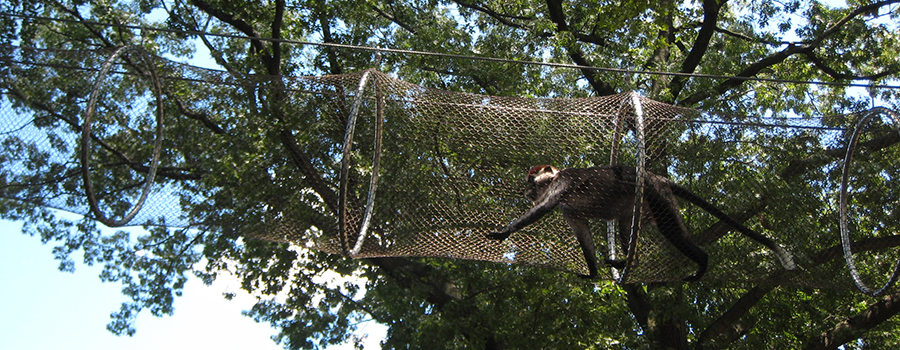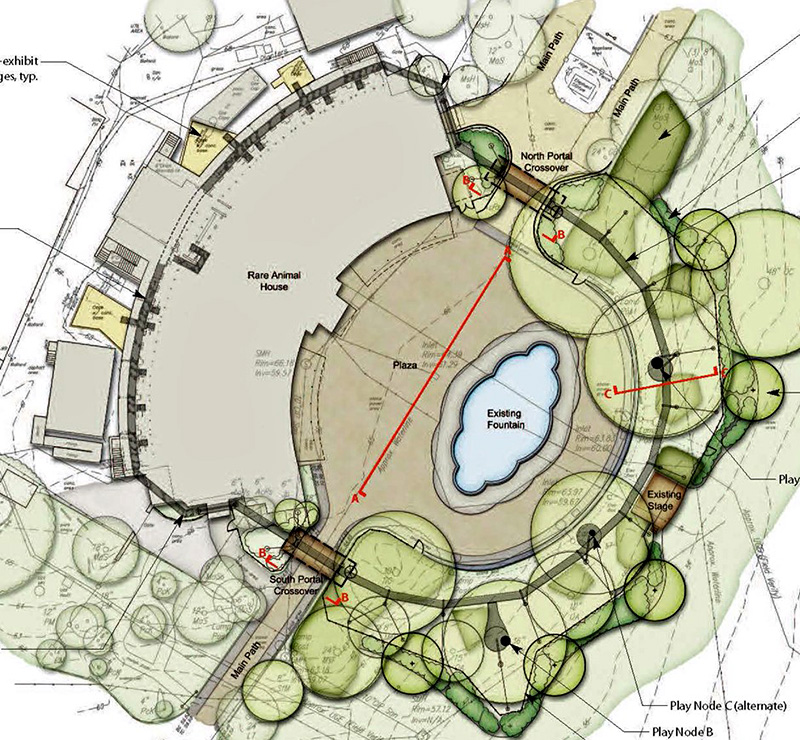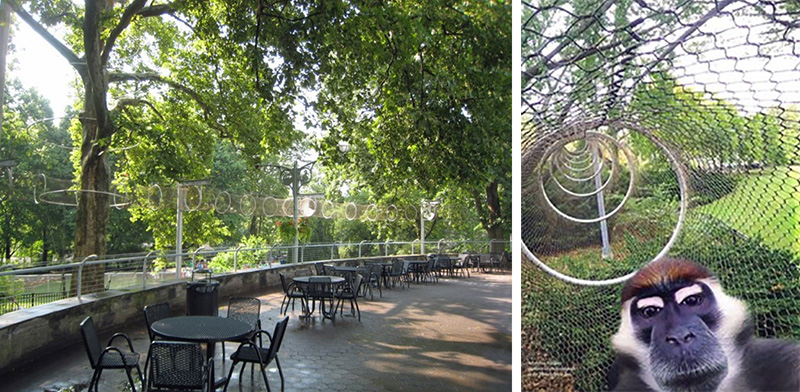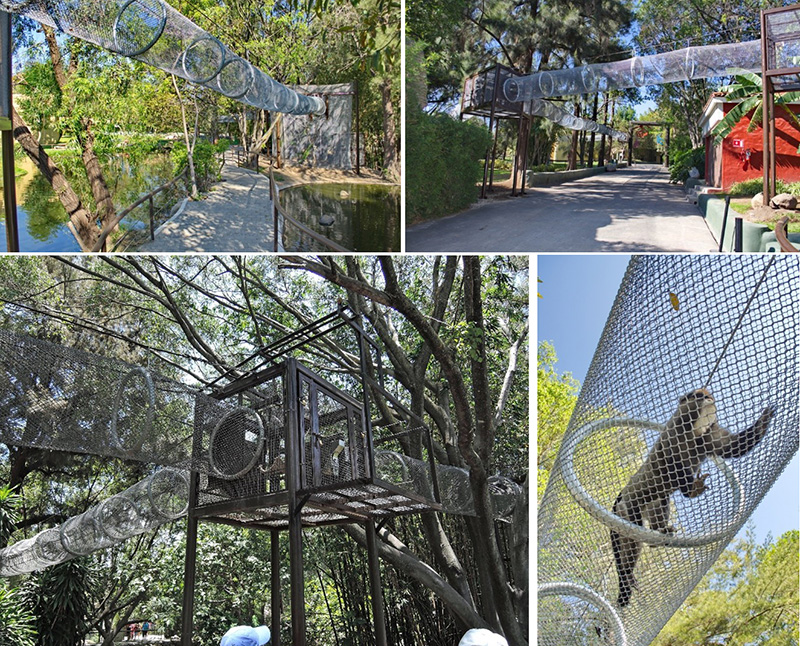Small Primates
Small Primates
The following material applies to primates other than great apes, mid-sized primates such as mangabeys to tiny tamarins and marmosets. While species are specialists with particular as well as individual needs, they share essential characteristics, such as being highly intelligent, curious, social, agile and, for the most part, arboreal – needing access to verticle space. Many species have been carefully studied, both in naturral habitats and especially in managed populations. These factors make primates ideal candidates for innovations in management and housing such as multispecies trail systems, animal computer interactions (ACI) and other features and programs providing greater opportunities for animals to manage their own lives with our support.

Treetop Trail, Part of the Philadelphia Zoo 360 concept Jon suggested with Curator Andrew Baker, is over 500m long and used alternately by more than 15 smaller primate species. Several zoos in the United States, Mexico, Australia, and New Zealand have adapted variations on this animal rotation and enrichment concept. (Photo: Philadelphia Zoo).
Papers on theory and design of small primate facilities
Coe, Jon C., 1989. “Naturalizing Habitats For Captive Primates” in Zoo Biology, vol. 8, no. S1, pp. 117-125.
Coe, Jon C., 1992. “Animal Training and Facility Design – A Collaborative Approach”, Perspectives on Training in the Zoo — Great Challenges, Profound Benefits, 1992 AAZPA National Convention Proceedings, Toronto, American Association of Zoological Parks and Aquariums, Bethesda, MD, pp. 411-414. Abstract
Coe, Jon C., 1995. “Giving Laboratory Animals Choices” in Lab Animal Magazine, Vol. 24, No. 7:41-42.
Coe, J. C., Lindburg, D. G., 1995. “Ark Design Update: Primate Needs and Requirements” in Conservation of Endangered Species in Captivity, An Interdisciplinary Approach, Gibbons, E. F., Durrant, B. S., Demarest, J., Eds., State University of New York Press, pp. 445-57.
Coe, Jon C., 1995. “Zoo Animal Rotation: New Opportunities from Home Range to Habitat Theater” in AZA Annual Proceedings 1995, Wheeling, WV, pp. 77-80. Abstract
Coe, Jon C., 1999. “Increasing Affiliative Behavior between Zoo Animals and Zoo Visitors” in 1999 AZA Convention Proceedings, American Zoo and Aquarium Association, Silver Spring, MD, pp. 216-220. Abstract
Coe, Jon, 2014 . “Next Generation Rotation Exhibits – Raceway Networks and Space to Explore ” Zoo and Aquarium Association Annual Conference, 25-28 March 2014, Auckland NZ
Coe, Jon 2017, “Embedding Environmental Enrichment into Zoo Animal Facility Design“, Wroclaw Zoo Design Conference.
Small Primate Exhibits of Note
- Asian Primate Exhibit, Woodland Park Zoo, Seattle, Washington, 1978, J&J
- Mandrill Exhibit, Zoo Atlanta, Georgia 1986, CLR

Treetops Trails, Philadelphia Zoo
While Jon developed the overall Treetop Trails design concept, his old firm CLRdesign developed design details as well as this plan showing the first stage connecting the existing primate indoor dioramas in the heritage Rare Mammal House to the outdoor loop circling the existing Impala Plasa near the Philadelphia Zoos’ main entry. Note the two gateways protecting visitors on the main walkway from possible urine from the primates crossing above, and also the three off-trail play nodes where primate can spend time with enrichment features and feeders. Two important features of this concept are 1. It integrates well with a protected heritage building and 2. The use of existing park land to greatly expand opportunaties for the primates. Philly Zoo developed the slogan “As you move through the zoo, the zoo moves around you!”

The left photo shows the loop trail passing near picnic tables with one of the play nodes built around a large existing sysamore tree. The photo on the right shows a mangabey’s view from inside the trail (photo: Philadelphia Zoo).
Treetop Trails was the first of the Philly Zoo360 animal rotation trails and opened in 2011. It included 152m (500lf) of one meter diameter flexible mesh circling the public area and 76m (250’) of square cross section ridged mesh over the old Rare Mammal building connecting to eleven existing indoor primate exhibits. The total length is 228m (750’). Initially ten species of primate alternately used the trail loop: Red-capped mangabey, Blue-eyed black lemur, Mongoose lemur, Douc langur, Geoffroy’s marmoset, Goeldi’s monkey, Golden lion tamarin, Pied tamarin, White-faced saki, and pygmy marmoset. Coquevel’s safaka and black and white roughed lemurs were later included.
Dr. Marieka Gartner studied the primate’s anticipatory behaviour and choice when offered access to the Treetop Trails. She found that lemurs chose to use the trail 80% of the time. Occausions they chose to stay home may have been weather related. Unfortunately, no data was published on how the various primates used the trails or the length of time and frequency of their use.
Treetop Trails was later extended to a total length of 500m (1640’), creating a round trip length of one kilimeter, a long distance for a pygmy marmoset!
- Treetop Trails, Philadelphia Zoo, Pennsylvania, 2009, JCD/CLR
- Lemur Entry Exhibit Concept, Melbourne Zoo, Victoria, 2011, JCD
Sendario Aerios, Zoo Guadalajara, Mexico
In 2013 Jon was invited to Zoo Guadalajara to give a lecture at their Future of Zoos Conference. During his tour of the zoo with Primate Curator Dr. Luis Soto Rendón Jon suggested they develop elevated trails (Sendario Aerios) for some of their primates and later Dr. Rendón sent Jon photos of the completed work which Jon visited in 2018. The completed trail loop is 600m (2000’) long, was constructed by zoo staff and is very popular with zoo visitors.

Note that unlike Treetop Trails at Philadelphia Zoo, Sendario Aerios crosses and even follows public pathways without concern for visitors standing below the primates. They also simplified the gateways between trail segments.These long trails provides a variety of exercise and exploration opportunities for several primate species. During Jon’s second visit, black and white roughed lemurs alternated with a large troop of squiral monkeys. Each species enjoyed a half of the day in the trail system before returning to their usual enclosures.
- Sendarios Aerios (small primate overhead trails) Zoo Guadalajara, Mexico, 2013, JCD
